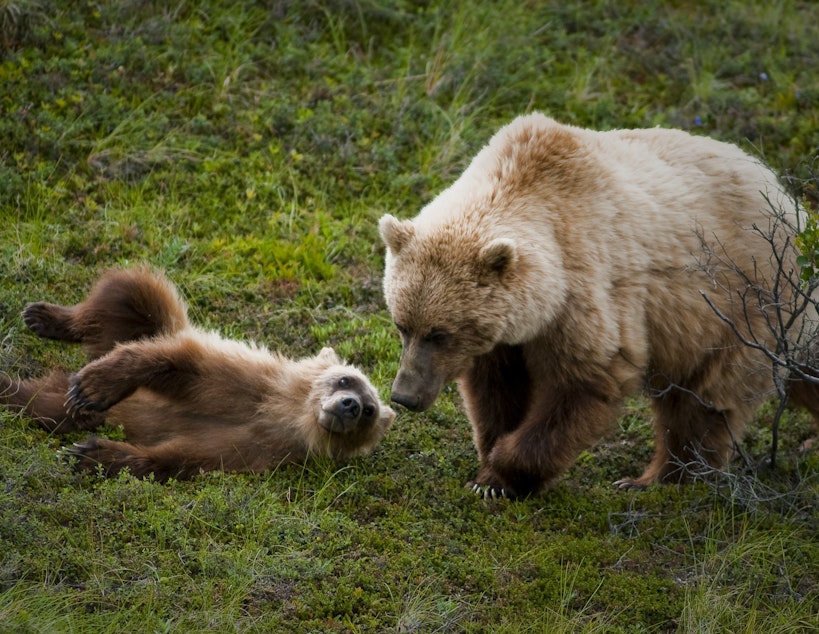More grizzlies coming to the North Cascades

Grizzly bears will be brought into Washington’s North Cascades. After more than 30 years of work, the federal government decided on a plan to slowly transport the grizzlies into the wild, remote landscape.
“We can exhale a bit but not too much,” said Joe Scott, the international conservation director with Conservation Northwest. “The real work of grizzly bear recovery starts now. Now we get into the nitty gritty of, of you know, getting the bears on the ground and hoping they survive and keeping them secure and safe and educating folks about how to live with them.”
However, some orchardists and ranchers in Okanogan County have raised concerns about bringing another top predator onto the landscape.
“We think the grizzlies are going to come to the orchards, where there are apples. They’re going to maul our workers. It’s going to be very dangerous,” said orchardist Sandee Freese in an earlier interview.
The National Park Service and the U.S. Fish and Wildlife Service plan to bring in three to seven grizzlies within five to 10 years. The goal is to reach a founding population of 25 bears.
Sponsored
Federal officials plan to move the bears in from other healthy ecosystems that are similar to the North Cascades, including places like Montana, Wyoming and interior British Columbia. They’ll use culvert traps to capture the bears, with capture and release generally happening between June and September.
Federal officials aim to capture bears 2 to 5 years old with no history of conflict. Officials hope to bring in more female bears than male bears.
The bears will be brought in with a helicopter to areas that are largely roadless, have minimal human use and berries that bears like to eat.
In the end, around 200 grizzly bears could be translocated to the North Cascades over the next century.
“It's not an easy animal to recover from zero,” Scott said. “It's tough; they reproduce slowly, they have challenges dispersing from their home ranges, and it's just going to take a long time. I think people don't really don't realize the length of time it takes for grizzly bear populations to grow.”
Sponsored
That growth in grizzly numbers will benefit the ecosystem, said Scott Schuyler, a tribal elder and natural and cultural resources policy representative for the Upper Skagit Indian Tribe.
For years, biologists have suspected only a handful of grizzly bears likely live in the North Cascades. There are so few bears that the population is considered functionally extinct.
“To us, an ecosystem that is missing chains or links of a chain of a complete ecosystem. That's what we want to see. We want to see everything there that should be there,” Schuyler said.
Grizzly bears dig prolifically, tilling and aerating soils, spreading seeds, contributing to an ecosystem’s biodiversity, Scott said.
The Skagit Tribe has lived with grizzlies for at least 9,000 years, Schuyler said, noting a river village once existed at the current site of Newhalem, Washington. The name for nearby Stetattle Creek was derived from the stəbtabəl’, or grizzly bear, in the Upper Skagit people’s Lushootseed language.
Sponsored
“This is also a social injustice issue, from our standpoint because we've always had the ability to address this and bring bears in, though we haven't done that,” he said.
The tribe gave grizzlies respect, and the bears gave them respect in return, he said.
Nevertheless, he said, the tribe understands people’s safety concerns while recreating and living in grizzly country. It’s a big reason for a major change to this most recent grizzly translocation proposal: the 10(j) rule, which designates the bears as an experimental population.
Grizzlies are federally threatened under the Endangered Species Act.
That rule will allow land managers and officials flexibility to deal with bears that cause problems.
Sponsored
That did little to comfort people who’d pushed against bringing in grizzlies. U.S. Rep. Dan Newhouse, R-Washington, has loudly opposed relocating grizzlies to part of the district he represents. He called the plan outrageous.
“No amount of local opposition was going to prevent these federal bureaucrats from doing what they wanted all along,” Newhouse said in an emailed statement.
The debate has gone on for years. Before this inception, the federal government in 2020 abruptly stopped a similar look into moving in grizzly bears. When the question of bringing in grizzlies reopened nearly two years later, people questioning the move said they felt their complaints weren’t heard.
“Why are we here again? We were here in 2019. Didn’t you hear us? Didn’t you hear us? I’m asking you,” Naomi Noel said, pointing at public officials during a public hearing last October.
On the other hand, Schuyler said he’s seen grizzlies elsewhere and hopes he will be around to see the bears in Washington.
Sponsored
“My personal hope is that I live long enough to be able to see a bear in the North Cascades,” Schuyler said. [Copyright 2024 Northwest News Network]
